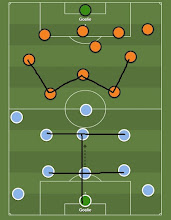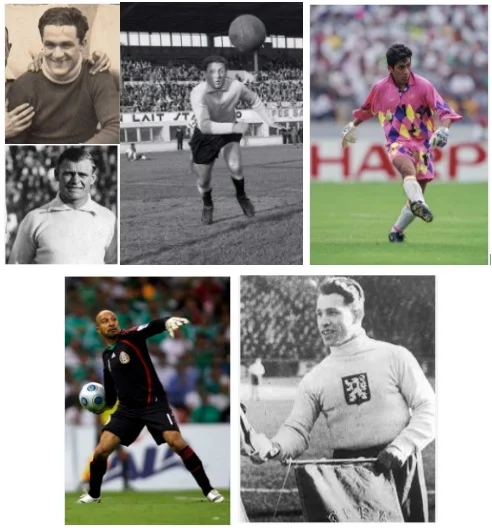A goalkeeper has been a crucial position in football, and height has become
a more and more important requirement to be a shot stopper, especially at the
top level. In addition, goalkeepers have been pushed to have ball control and
reading the game ability as they tend to be integrated in attacking build-up in
the modern game.
Regarding the height, it is almost impossible to find a man between the
sticks who is below 175 cm tall. The shortest goalkeeper in the European top five
is still 180 cm tall. He is the current Real Valladolid man, Jordi Masip.
Nevertheless, there have been such notable short goalies at the top level in
football history. Two of them even got a nod to feature in two FIFA World Cup
finals. Here are those distinguished shot stoppers without the height advantage
but still managed to be the first choice in his club and earn international
caps.
Juan Botasso (Argentina)
He was one of the shortest goalies in football history at the top level.
Botasso was only 169 cm but managed to feature in the first FIFA World Cup
final. He replaced the first choice, Angel Bossio, for the semifinal and the
summit in Uruguay in 1930.
The former Quilmes man made nine appearances for Albiceleste and was part of
the squad when they won Copa America 1929, despite not featuring in a single
game. He was at the peak of his form while playing for Racing Club, where he
also lifted two domestic titles. Botasso stayed there from 1930 to 1938 before
returning to Quilmes, which was competing at the second tier at that time.
|
Clubs (Appearances (clean sheet)) |
International caps |
Notable games |
Individual awards |
|
Quilmes Racing Club |
9 |
-Argentina vs USA 6-1 (1930 FIFA World Cup semifinal) -Argentina vs Uruguay 2-4 (1930 FIFA World Cup final) |
|
Jorge Campos (Mexico)
The 168-cm tall goalie cemented his status as the main goalie in 1990/91 but kept on being deployed as a field player whenever his team was in need of scoring. Campos even managed to bag a goal from a bicycle kick for Atlante in the 1996/97 season.
His international appearances began in 1991 under Cesar Luis Menotti’s
tutelage, but he no longer played a double role as a goalie and occasional
striker. Campos featured in 129 games, including in the 1994 and 1998 FIFA
World Cups. His attractive attire and eccentric form on the pitch drew the
fans’ interest. He went on playing for El Sombrero till 2003.
The Acapulco-born shot stopper delivered three silverwares for Mexico: the CONCACAF
Gold Cup twice and the Confederation Cup in 1999, plus reaching the final and
third place in Copa America 1993 and 1999 editions. Meanwhile, at
the club level, Campos helped UNAM, Cruz Azul, and Chicago Fire to win the
CONCACAF Champions Cup, MX Liga, and MLS Cup, respectively.
|
Clubs (Appearances (clean sheet)) |
International caps |
Notable games |
Individual awards |
|
UNAM ( 87 (19)) Cruz Azul ( 2 (1)) Atlante ( 42 (14)) LA Galaxy (52(15)) Chicago Fires (10 (0)) Tigres UANL (17 (6)) Puebla FC (28 (3)) |
129 (50 clean sheet) |
-Mexico vs Italy (1994 FIFA World Cup) -Mexico vs Ireland (1994 FIFA World Cup) - Mexico vs Brazil (Confederation Cup 1999 final) |
-MX Liga Best Goalie (1991-1995) -IFFHS World’s Best Goalie (3rd place in 1993) -CONCACAF Gold Cup Best Player (1991) |
|
Clubs (Appearances (clean sheet)) |
International caps |
Notable games |
Individual awards |
|
RC Strasbourg (114 (26)) Limoges FC (42 (56)) FC Metz (111 (31)) Sochaux (115 (29)) Bordeaux (-) Thillot (-) Grenoble (-) |
26 (7 clean sheet) |
-France vs Paraguay (1958 FIFA World Cup) - Strasbourg vs Rouen (French Cup 1964 final) |
- |
|
Clubs (Appearances (clean sheet)) |
International caps |
Notable games |
Individual awards |
|
CO Roubaix-Tourcoing Lille Montpellier Red Star Olympique FCO Charleville O Lillois |
25 (5 clean sheet) |
Red Star vs FC Sete 24 (French Cup 1942 final) |
Best French Goalkeeper in the Century in 1999 by L’Quipe |
He was the
former understudy of Jorge Campos in El Tri. Perez was slightly taller than his
senior, 170 cm, but followed Campos’ footsteps in his career. He was the second
Mexican goalie to play in Copa America final after Jorge Campos. Perez did it
in 2001 edition when his nation lost to the host Colombia. The former Pachuca
man also featured in two World Cup editions, 2002 and 2010, won CONCACAF
Champions Cup with Cruz Azul (twice) and Pachuca (once), plus MX liga. He even
also scored goals for his team, one each for Cruz Azul, and Pachuca plus one
with Mexico U23 side.
To certain
extent, the goalie who was easily recognized with his bald look during his
playing years even achieved more accolade than Jorge Campos. He contributed in helping
Cruz Azul to reach Copa Libertadores final in 2001. It was the first Mexican
club to play in South American top tier club tournament final in history. Perez
also won CONCACAF Gold Cup three times. Overall, he made 55 appearances for El
Tri with 23 clean sheets.
|
Clubs (Appearances (clean sheet)) |
International caps |
Notable games |
Individual awards |
|
Cruz Azul (407 (110)) Pachuca (185 (50)) Tigres UANL (32 (11)) Necaxa (34 (9)) San Luis (64 (16)) Jaguares (32 (7)) |
57 (23 clean sheet) |
Mexico vs Croatia (2002 FIFA World Cup) Mexico vs France (2010 FIFA World Cup) |
|
Frantisek Planicka (Czechoslovakia)
He was
regarded one of the best goalkeepers in the world before World War II. Planicka
was the second short goalkeeper who appeared in FIFA World Cup final. Unlike
Botasso, he was Czechoslovakia’s main goalkeeper in the team. In fact, he was
even the skipper in 1934 FIFA World Cup final. The Zizkov-born shot stopper featured in six world cup games, all four in 1934 and two games in the following edition.
Unfortunately,
he was badly injured in the quarterfinal match against Brazil. Czechoslovakia
managed to hold them in a 1-1 draw but lost 2-1 in a replay with Planicka and
their frontman Oldrich Nejedly on the sideline. Both were in fact suffering
broken bones and forced to retire from football. Overall, the goalie who was
nicknamed The Cat of Prague, due to his agility and attractive moves between
the sticks was capped 73 times.
Planicka was
only 172 cm tall and had been snubbed in his early years while being on a trial
with Sparta Prague. Fortunately, his talent kept drawing interests from other
clubs. Initially, it was SK Bubenec, which he joined in 1921 before signing for
Sparta Prague’s local rival, Slavia Prague two years later. He then became the
legendary player there and won eight league titles plus Mitropa Cup (the
predecessor of UEFA Champions Cup) in 1938.
|
Clubs (Appearances (clean sheet)) |
International caps |
Notable games |
Individual awards |
|
Slavia Prague SK Bubenec |
73 (12 clean sheet) |
-Czechoslovakia vs Italy (1934 FIFA World Cup final) -Slavia Prague vs Ferencvaros (Mitropa Cup 1938 final) |
Best goalkeeper in 1938 FIFA World Cup |



Comments
Post a Comment